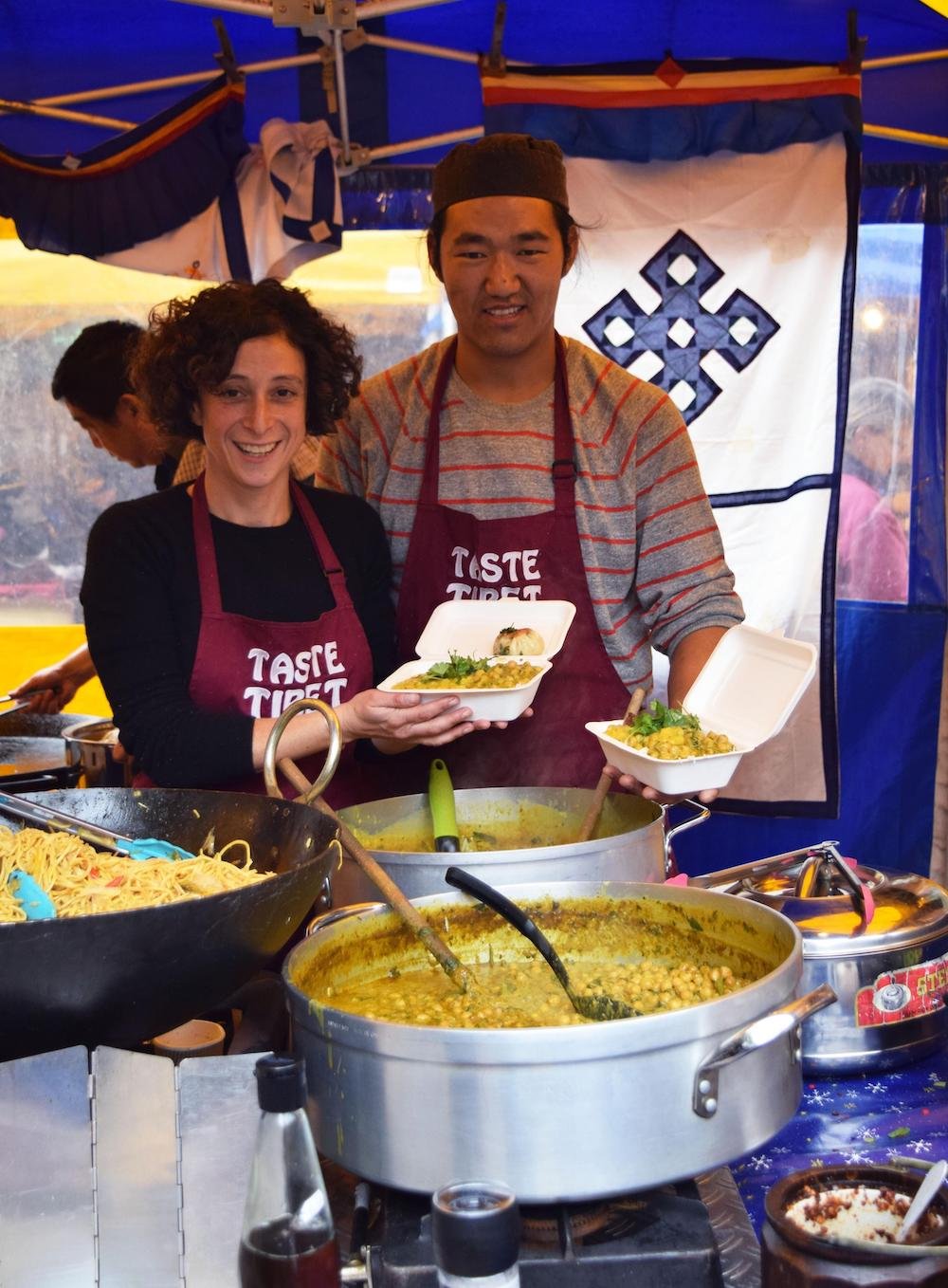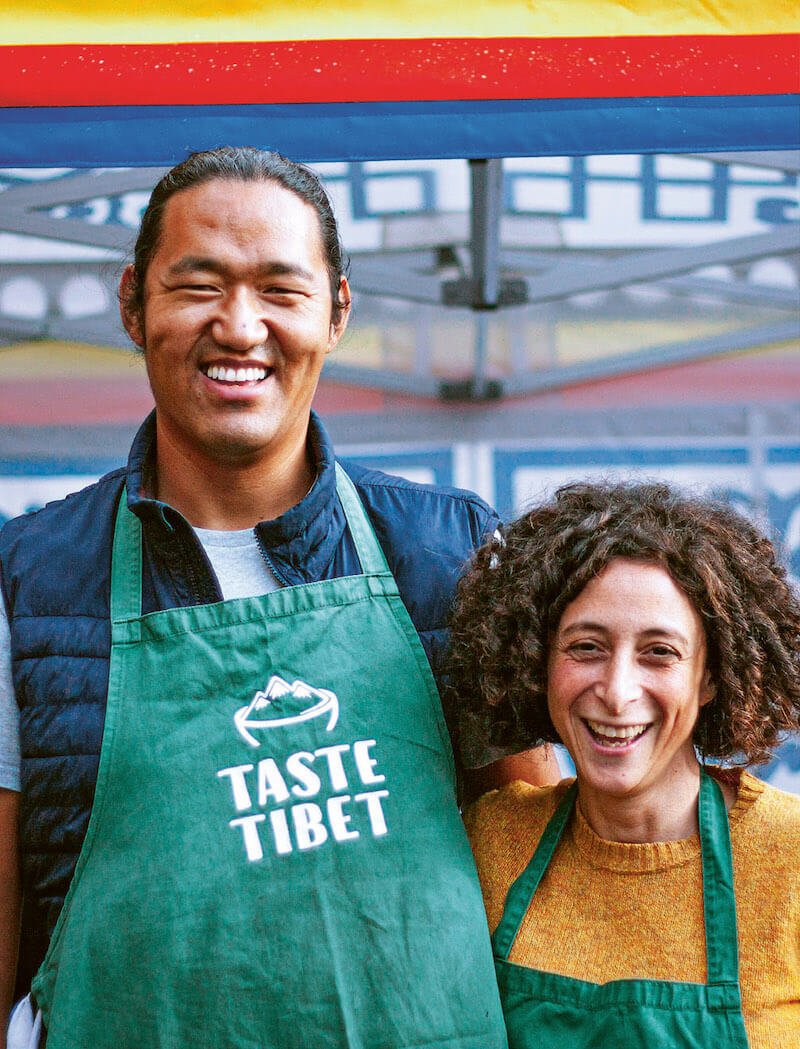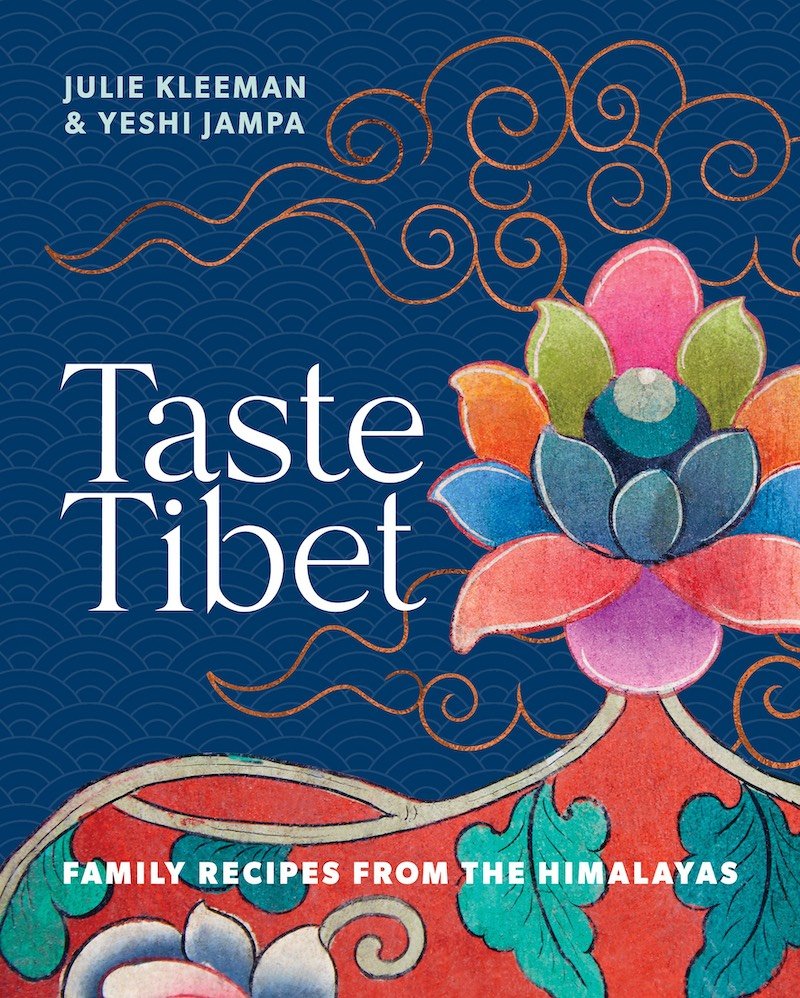Advertisement
Cookbook Preview: Taste Tibet
17 March 2022 · Cookbook Preview · Family Favorites
Julie Kleeman met Tibetan chef Yeshi Jampa in 2009 in the Indian town of Dharamsala, which lies at the edge of the Himalayas. Together they have brought Tibetan food (including the hugely popular momo dumplings) to wider attention in the UK through popups, festivals and, since 2020, a restaurant in Oxford.
In 2019, Julie won the Yan-Kit So Memorial Award for Food Writers on Asia, a scholarship that supports travel and research. The award is given in memory of the late Yan-Kit So, whose works on the cuisines of China make up “essential reading for anyone interested in Chinese food,” according to best-selling author Fuchsia Dunlop.
Julie and Yeshi’s first cookbook, Taste Tibet, is published on March 17, 2022. We caught up with the authors to get the inside info on yaks, momos, and butter tea…
Q & A with Julie Kleeman

Taste Tibet started as a street food stall and was a finalist in the 2021 BBC Food and Farming Awards.
Q: You mention in the book that Yeshi learned to cook from practical experience and that cookbooks aren’t widely used in Tibet, but it sounds like you are an avid cookbook fan. Who are some of the cookbook authors you admire?
I am a big fan of Fuchsia Dunlop. I lived in China for many years, and Fuchsia’s books helped me to replicate at home many of the dishes that I enjoyed eating out. Her recipes are so authentic, simple, and delicious. And they really work!
I also love reading Claudia Roden. Her recipes and stories are so evocative – she really knows how to set a scene. And, of course, she’s an immigrant cook, something that both I and Yeshi can relate to. My own mother was born in Egypt, like Claudia, so many of her recipes feel familiar to me.
Q: You won the 2019 Yan-Kit So Award, a travel fellowship for food writing about Asia. How did the pandemic affect that?

Yan-Kit So’s magnum opus, Classic Food of China.
The prize for winning the Yan-Kit So Award was a grant towards travel in the region. We had a big research trip in Tibet planned for February–April 2020. Of course, it didn’t happen. But before the pandemic hit I made some life-long friends and valuable contacts at the Award ceremony. Among them, Ken Hom has become something of a pen pal – his frequent emails bring me great joy. I met my agent, Heather Holden-Brown on the night, and she guided me so effortlessly through to publication that I think I didn’t appreciate how difficult the process of finding and securing a publishing deal really is. Fuchsia Dunlop was a judge on the Award panel, and she recently gave us a wonderful endorsement for our own cookbook – a beautiful case of things coming full circle.
Without being able to travel to Tibet, Taste Tibet is a different book from the one we originally imagined we’d put together. It’s a record of the Tibetan food that Yeshi cooks at home and at the restaurant and food stall. We’d still love to make the trip to Tibet at some point to write something more immersive. Book two!
Q: Yak meat and milk are not so easy to come by in the UK, but you mention that beef is fine as a substitute. How does yak meat compare? Have you tried UK-raised yak meat?

Yak meat has a flavour profile similar to lean beef or buffalo. It’s usually cured and air-dried for use over long periods of time. It can be enjoyed as a raw snack in this form, or added to soups and stews. Before cooking it is chewy in the mouth initially, before melting away very quickly.
We haven’t tried UK-raised yak meat. The monks at a monastery in southern Scotland keep a few yaks in the grounds, but when we visited they didn’t look like they were thriving – the conditions in the UK are just too damp. [There is, in fact, one yak farm in the UK offering Yak meat online!]
Q: Any other tips on sourcing ingredients? Tsampa, the Tibetan staple made from ground dry-roasted barley, sounds interesting. Does regular pearl barley available in the UK produce authentic tsampa?

Tsampa, made from ground roasted barley, can be used in a multitude of ways – including chocolate truffles!
Yes. This is what we use at home, and it works well. Yeshi likes brown barley grains and we have been able to source these in the UK too, but there’s no need to look beyond pearl barley in your local supermarket if you’re planning to have a go. All the ingredients used in the book’s recipes are available either at your local supermarket or in a nearby Chinese or Indian supermarket, if there is one local to you. Otherwise you can find them online.
Q: It sounds like Tibet’s food is quite a melting pot with Indian, Chinese, and Nepalese influences?
Throughout history, Tibet had open trade routes with Nepal and India. Key mountain passes made this possible. The situation became more complex in the 1950s and ’60s, once the Chinese had established themselves in Tibet, but there is a long history of trading, mostly centered around salt (from Tibet) and rice (into Tibet), etc. Tibetans also imported tea and other produce from China, and so on.
Some elements of the Tibetan diet are unique – the use of yak meat and dairy, for example, as well as tsampa, but Tibetans and Nepalis share momos (steamed dumplings), and the Chinese have their versions of these too, of course. Spice entered the Tibetan cuisine from India and was very much welcomed. In recent times, Indians have also loving embraced elements of the Tibetan cuisine into their restaurant and street-food scene.
A large number of Tibetan people are now living outside of Tibet – mostly in Nepal and India. Even those Tibetans who make it to other parts of the world – Europe, the US, etc. – have often spent many years in south Asia, where the climate is very different, and whole new worlds of food opened up to them. Yeshi lived in India for over a decade, picking up many new ingredients and flavours along the way. The same is true for Tibetan cooks in every Tibetan eatery across the world: each has made their own unique journey out of Tibet, and their menus tell the story.
Q: You mention that when you first started, you focused on momos (Tibetan dumplings). What are other favourites in the restaurant that people keep coming back for?
Momos are the food that everyone talks about. They are our signature dish. But the one that they secretly can’t get enough of is the Taste Tibet Famous Chicken Curry. This is the festival-goer’s cure-all, and every Oxford customer’s guilty pleasure. I say guilty because many of our customers are veggie, but while they’ll order away our Heavenly Vegan Momos, they can’t leave the building without sneaking in at least one portion of our Famous Chicken Curry. All of this plus some Taste Tibet Sepen (hot chilli dip). This is Yeshi’s legendary spicy condiment, a great pairing for momos and curry alike. We have this in jars for takeaway, and they fly off the shelves.
Q: You mention in the book that the first thing people should make is a big jar of sepen. What makes sepen so special?

Sepen: a super-fiery blend with a tongue-numbing effect.
Tibetan food is not usually spicy, unless you slap on the sepen. Spices do feature in some dishes, but the ultimate level of heat tends to be determined by how much sepen you add to them. A super-fiery blend of dried chilli, garlic, ginger and Sichuan peppercorns (yerma), it has a wonderfully tongue-numbing effect, and is a singular Tibetan culinary experience. In Tibet, every family has its own unique recipe. The one that we cook is Yeshi’s dad’s – he famously made the best sepen around. Yeshi’s sepen is full of warmth and has a delicious tongue-tingling hit from the yerma.
Q: The pandemic was a tough time for the restaurant industry, but Taste Tibet seems to have come through in good shape and with a great cookbook to show for it! What did you learn, and what are your next goals for Taste Tibet?

Yeshi and Julie outside their restaurant in Oxford.
We have had such a busy couple of years. During the early stages of the pandemic we had just begun renovating the premises that ultimately became Taste Tibet’s first fixed site (opened during the second lockdown in November 2020). Our summer of festivals fell away before our eyes and we desperately needed to keep renovation work going and the restaurant plan on track. Within a week of Lockdown 1 we had set up as a deliveries business. It was easier for our inexperienced deliveries fleet (i.e. us!) to deliver food chilled instead of hot, and ultimately this has become a sideline business for us now that the doors to our restaurant are open, so positive things have happened along the way. We also met a lot of new customers on our rounds, and everyone has been incredibly loyal and supportive to us on what’s been a difficult journey. Of course, we were writing our cookbook all the while…
We learned that we had a resilience and a spirit of entrepreneurship that we never knew we had, and that diversification is important in a business, as well as openness to change. We feel a lot stronger looking back at everything we’ve achieved, and we’re a lot more confident about what we’re offering because we see such a strong and enthusiastic response to it.
In time, we would love to open more locations, and to grow our chilled foods line that was born during lockdown. We have always been driven to give Tibetan food more visibility, and these different approaches give us different opportunities to get people enjoying Tibetan food in a variety of ways. Of course, the cookbook is also part of this mission.
We think that the Tibetan cuisine offers unique approaches to healthy eating, as well as mindful and conscious consumption – it’s a very timely offering. Plus it’s delicious! We’re so excited to get more people cooking and enjoying Tibetan food. This is a cuisine that will be new to most people, but with lots of dumplings, noodles, soups, stir-fries, and curries we also know that it will be familiar in many ways.
Taste Tibet is available to buy in print now from all good booksellers, and is also available in full online for ckbk members.
A selection of recipes from Taste Tibet
“Yeshi and Julie are brilliant at explaining how dishes such as momo dumplings and sweet ceremonial rice are traditionally eaten on the Tibetan Plateau, yet their recipes are so clear and reassuring they will appeal to readers anywhere.”
Fuchsia Dunlop, author of Every Grain of Rice and The Food of Sichuan
Listen to Julie and Yeshi on Gilly Smith’s Cooking the Books podcast
About the authors

Julie Kleeman studied Chinese at Cambridge University and has been traveling and eating in Asia since 1992. She lived in Beijing for many years, where she worked as the chief editor of the Oxford Chinese Dictionary. Yeshi Jampa grew up in Tibet, herding livestock on the high reaches of the plateau and learning to cook inside a yak-hair tent at a young age. When he was 19, Yeshi walked across the Himalayas to northern India, where he and Julie later met. Yeshi’s soups and stir-fries won Julie’s heart, and they are now married with two children and living in Oxford, UK. Together, they own and run the Taste Tibet restaurant and festival food stall, a Guardian and BBC Good Food Top Ten pick, and a finalist in the Best Street Food or Takeaway category in the 2021 BBC Food and Farming Awards. Julie and Yeshi share a passion for food and well-being, and have made it their mission to get Tibet on the global food map.
Listen to Julie and Yeshi on Gilly Smith’s Cooking the Books podcast
Sign up for ckbk's weekly email newsletter
Related posts
Behind the Cookbook
The story behind the creation of My Big Fat Greek Cookbook.
Advertisement





